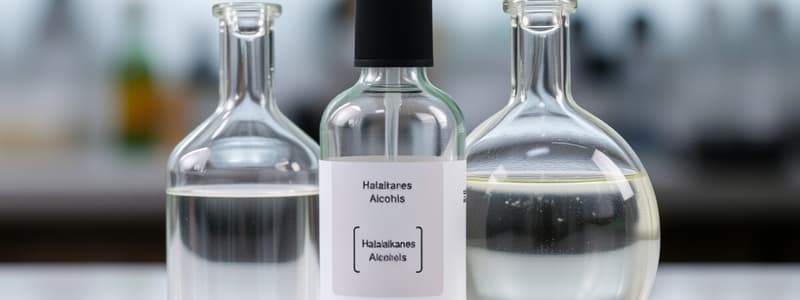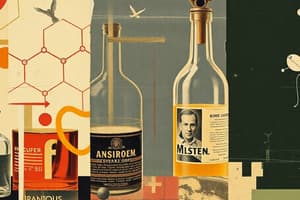Podcast
Questions and Answers
What is a defining characteristic of aldehydes compared to ketones?
What is a defining characteristic of aldehydes compared to ketones?
- Aldehydes typically have higher boiling points than ketones.
- Aldehydes do not participate in nucleophilic addition reactions.
- Aldehydes have a carbonyl group at the end of the carbon chain. (correct)
- Aldehydes are less reactive than ketones.
Which of the following statements about amines is correct?
Which of the following statements about amines is correct?
- Amines are classified based on the number of hydrogen atoms replaced by alkyl or aryl groups. (correct)
- All amines are derived from aliphatic compounds only.
- Amines have lower boiling points than hydrocarbons due to no hydrogen bonding.
- All amines have a characteristic floral odor.
Which reaction can aldehydes undergo that ketones cannot?
Which reaction can aldehydes undergo that ketones cannot?
- Nucleophilic substitution.
- Reduction to alcohols.
- Formation of Grignard reagents.
- Oxidation to carboxylic acids. (correct)
What property of carbonyl compounds contributes to their relatively high boiling points compared to hydrocarbons?
What property of carbonyl compounds contributes to their relatively high boiling points compared to hydrocarbons?
Which method does not apply to the reactivity of haloalkanes?
Which method does not apply to the reactivity of haloalkanes?
How are amines generally characterized in terms of their basicity?
How are amines generally characterized in terms of their basicity?
What is the primary characteristic of haloalkanes?
What is the primary characteristic of haloalkanes?
Which type of isomerism is exhibited by compounds differing in the arrangement of atoms but having the same molecular formula?
Which type of isomerism is exhibited by compounds differing in the arrangement of atoms but having the same molecular formula?
Which reaction mechanism is commonly associated with the nucleophilic substitution of tertiary haloalkanes?
Which reaction mechanism is commonly associated with the nucleophilic substitution of tertiary haloalkanes?
What is a common oxidation product of a primary alcohol?
What is a common oxidation product of a primary alcohol?
What distinguishes phenols from alcohols?
What distinguishes phenols from alcohols?
Which of the following statements about ethers is correct?
Which of the following statements about ethers is correct?
What is the primary reason for the higher boiling points of alcohols compared to hydrocarbons of similar molecular weight?
What is the primary reason for the higher boiling points of alcohols compared to hydrocarbons of similar molecular weight?
Which type of alcohol is resistant to oxidation?
Which type of alcohol is resistant to oxidation?
Flashcards are hidden until you start studying
Study Notes
Organic Chemistry
- Definition: Study of carbon-containing compounds and their properties.
- Key Concepts:
- Structure and bonding in organic molecules.
- Functional groups and their reactivity.
- Isomerism: structural isomers vs. stereoisomers.
- Reaction mechanisms: nucleophilic substitution, elimination, addition, and rearrangement.
Haloalkanes
- Definition: Organic compounds containing halogen atoms (F, Cl, Br, I) attached to aliphatic carbon atoms.
- Classification:
- Primary, secondary, and tertiary haloalkanes based on the carbon atom to which the halogen is attached.
- Reactions:
- Nucleophilic substitution (SN1 and SN2 mechanisms).
- Elimination reactions (E1 and E2 mechanisms).
- Properties:
- Generally polar compounds with higher boiling points than corresponding alkanes.
- Used in solvents, pesticides, and refrigerants.
Alcohols
- Definition: Organic compounds containing one or more hydroxyl (-OH) groups.
- Classification:
- Primary, secondary, and tertiary alcohols based on the carbon to which the hydroxyl group is attached.
- Reactions:
- Oxidation: primary alcohols → aldehydes; secondary → ketones; tertiary → resistant.
- Dehydration: conversion to alkenes via elimination.
- Properties:
- Polar and capable of hydrogen bonding.
- Higher boiling points than hydrocarbons of similar molecular weight.
Phenols
- Definition: Compounds containing a hydroxyl group (-OH) directly attached to an aromatic ring.
- Properties:
- Weakly acidic due to the resonance stabilization of the phenoxide ion.
- Higher boiling points than alcohols due to hydrogen bonding.
- Reactions:
- Electrophilic aromatic substitution (e.g., nitration, sulfonation).
- Oxidation to quinones.
- Formation of esters and ethers.
Ethers
- Definition: Organic compounds characterized by an oxygen atom connected to two alkyl or aryl groups (R-O-R').
- Properties:
- Generally nonpolar and have lower boiling points than alcohols.
- Good solvents for organic reactions.
- Reactions:
- Cleavage by strong acids to form alcohols and alkyl halides.
- Not very reactive, but can participate in oxidation and hydrolysis under extreme conditions.
Carbonyl Compounds
- Definition: Organic compounds containing a carbonyl group (C=O).
- Types:
- Aldehydes: carbonyl group at the end of the carbon chain.
- Ketones: carbonyl group within the carbon chain.
- Reactions:
- Nucleophilic addition reactions with nucleophiles (e.g., Grignard reagents).
- Oxidation (aldehydes → carboxylic acids).
- Reduction (aldehydes and ketones → alcohols).
- Properties:
- Generally polar, leading to higher boiling points than hydrocarbons.
- Aldehydes are typically more reactive than ketones.
Amines
- Definition: Organic compounds derived from ammonia (NH3) by replacing one or more hydrogen atoms with alkyl or aryl groups.
- Classification:
- Primary (one R group), secondary (two R groups), and tertiary (three R groups).
- Reactions:
- Nucleophilic substitution: alkylation of amines.
- Formation of amides from carboxylic acids.
- Reactivity with acids to form ammonium salts.
- Properties:
- Basic nature due to the lone pair on the nitrogen atom.
- Higher boiling points than hydrocarbons due to hydrogen bonding.
- Characteristic fishy odor in lower molecular weight amines.
Organic Chemistry
- Focuses on carbon-containing compounds, examining their structures, properties, and reactions.
- Key concepts include structure and bonding, functional groups, isomerism (structural and stereoisomers), and various reaction mechanisms.
Haloalkanes
- Organic compounds with halogen atoms (F, Cl, Br, I) linked to aliphatic carbon atoms.
- Classified into primary, secondary, and tertiary based on the halogen-attached carbon's position.
- Undergo nucleophilic substitution via SN1 and SN2 mechanisms and elimination reactions (E1 and E2).
- Generally polar with higher boiling points than similar alkanes; utilized in solvents, pesticides, and refrigerants.
Alcohols
- Contain one or more hydroxyl (-OH) groups.
- Classified as primary, secondary, or tertiary based on the carbon attached to the hydroxyl group.
- React through oxidation (primary → aldehydes, secondary → ketones) and dehydration to form alkenes.
- Polar, capable of hydrogen bonding, resulting in higher boiling points than comparable hydrocarbons.
Phenols
- Characterized by the presence of a hydroxyl group attached directly to an aromatic ring.
- Exhibit weak acidity due to resonance stabilization of the phenoxide ion and possess higher boiling points than alcohols.
- React through electrophilic aromatic substitution (nitration, sulfonation) and oxidation to quinones, as well as forming esters and ethers.
Ethers
- Compounds with an oxygen atom bonded to two alkyl or aryl groups (R-O-R').
- Generally nonpolar and possess lower boiling points than alcohols; effective solvents in organic reactions.
- Can undergo cleavage by strong acids to yield alcohols and alkyl halides, and show reactivity in oxidation and hydrolysis under extreme conditions.
Carbonyl Compounds
- Defined by the presence of a carbonyl group (C=O).
- Two main types: aldehydes (carbonyl at the chain's end) and ketones (carbonyl within the chain).
- Participate in nucleophilic addition reactions, with aldehydes more reactive than ketones; they can oxidize to carboxylic acids and reduce to alcohols.
- Generally polar, resulting in higher boiling points than hydrocarbons.
Amines
- Derived from ammonia (NH3) with one or more hydrogen atoms replaced by alkyl or aryl groups.
- Classified into primary, secondary, and tertiary forms based on the number of R groups.
- React through nucleophilic substitution (alkylation) and can form amides from carboxylic acids, as well as ammonium salts upon reacting with acids.
- Exhibit basic properties due to the nitrogen's lone pair, higher boiling points than hydrocarbons due to hydrogen bonding, and a characteristic fishy odor in lower molecular weight species.
Studying That Suits You
Use AI to generate personalized quizzes and flashcards to suit your learning preferences.




